June 5, 2025—Welcome back to our Myth Busters series. If you caught our last blog, March Myth Buster: The Truth About Laser Resurfacing and Skin, you know we’re all about challenging outdated thinking with real science and clinical insight. In our June edition, we’re tackling a summertime misconception that still lingers: that laser treatments should be avoided in the warmer months.
Spoiler alert: With the right technology, a solid protocol, and good post-care, you can treat skin year-round and even support long-term skin health in the process.
In this blog post, we’ll walk you through a practical checklist for summer treatments and share stacked laser pairings that deliver results your patients will love, all season long.
Beyond the myth: How summer lasers can improve skin health
Treatments like Sciton’s BBL® HEROic™, a light-based treatment, and MOXI™, a 1927 nm fractional laser treatment, are proving that skincare can go beyond beauty, supporting healthier skin from the inside out.
“The newer 1927 nm lasers, part of the next generation of non-ablative fractionated lasers, are celebrated for correcting sun-damage, roughness, and pigmentation on all skin tones and types and are safe to use year-round,” explains Dr. Joel L. Cohen, MD, a board-certified dermatologist. “Recent data also suggest that regular use of non-ablative fractional lasers may help reduce precancerous lesions, such as actinic keratoses, and support long-term skin health,” he adds.
BBL HEROic also plays a role in supporting skin health.
Beyond delivering fast results with little to no downtime, studies suggest that consistent BroadBand Light® (BBL®) treatments may help skin appear smoother, clearer, and more youthful over time. “I always tell patients that if you used every product in the world every day for the rest of your life, it wouldn’t do what one BBL HEROic treatment can do, and I feel very strongly about that,” says Dr. Sherrif Ibrahim, MD, PhD, a board-certified dermatologist.
While the science supports safe laser use year-round, clinical success in summer still depends on protocol precision and patient compliance. Here’s how to get it right.
✅Your summer laser checklist
Use this checklist to prep your team, fine-tune protocols, and keep outcomes strong throughout the summer months and beyond. The following recommendations were shared in Sciton’s educational webinar, Supercharge Your Practice All Summer with Sciton Treatments, with Dr. Ann Watwood, MD, a naturopathic physician specializing in cosmetic dermatology. For detailed clinical protocols, refer to your device’s official user manual or contact your Clinical Educator.
Seasonally adjusted protocols
Tailor every treatment to skin type, sun exposure history, and the area being treated. With the right planning and care, even intensive laser procedures can be performed during the summer and sunnier months. Start with these essentials to guide your summer protocols:
☑️ Start with a lifestyle and sun protection review during the consultation. Ask about daily sun exposure, upcoming vacations, outdoor habits, and SPF use to set expectations and guide treatment timing. Dr. Watwood recommends asking targeted questions to understand your patient’s sun exposure and daily habits to personalize treatment plans and minimize risk.
-
- Do they wear mineral SPF daily and reapply every 60–90 minutes?
- Do they use hats, UV clothing, sunglasses, or seek shade regularly?
- Are there any upcoming vacations or outdoor events planned?
- Do they frequently garden, exercise, or walk their dog outdoors?
- Are they a boater or spend extended time in the sun?
☑️ Choose the appropriate laser or light-based treatment for patients’ skin type. Sciton technologies can all be used in the summer with the proper protocols. Our Which Fitz Fits brochure makes it easy to match the right technology to your patients’ needs—from pigment to texture and beyond.
☑️ Adjust your treatment settings based on skin type, recent sun exposure, and treatment area. This helps reduce the risk of post-inflammatory hyperpigmentation (PIH) and supports consistent, effective outcomes.
☑️ Document each patient’s natural (baseline) skin tone and adjust energy and treatment intervals, especially for melanin-rich or recently tanned skin. Baseline tone provides a reliable reference point for treatment planning, especially if patients fluctuate between visits due to sun exposure.
☑️ Evaluate skin for recent sun exposure and delay treatment if needed. Dr. Jason Pozner, MD, recommends performing a test spot with the laser and waiting at least 10 minutes to assess the skin’s response before proceeding. Tune into the ScitonStaX Summer Edition webinar to hear more about Dr. Pozner’s summer protocol.
Proactive PIH management
PIH is a common concern in summer, especially in melanin-rich skin types. The following steps help prevent and manage it effectively, while supporting optimal treatment outcomes:
☑️ Reinforce daily use of SPF 30+ and strict sun avoidance pre- and post-treatment. Emphasize SPF reapplication and explain why sun protection is critical for preventing inflammation and pigmentation.
☑️ Encourage physical protection, such as hats, shade, and UV-blocking clothing. These habits complement the use of SPF and help patients reduce incidental exposure they may not think about, like driving or walking the dog.
☑️ Schedule regular follow-ups to monitor healing and catch any early signs of pigment changes. For patients prone to PIH, Dr. Watwood uses tranexamic acid, clobetasol, or hydroquinone for the first 48 hours post-treatment and recommends frequent check-ins or photo updates to monitor progress. She emphasizes the importance of post-treatment cooling with Zimmer devices, ice packs, or cold-air exposure (even turning up the AC on the way home). Hear more pearls from Dr. Watwood in this blog post.
☑️ If PIH occurs, act quickly. Dr. Watwood addresses PIH with BBL, Groot’s cream (a combination of HQ, Retin-A, HC, Kojic acid, and Vitamin C), and diligent sun protection.
Cooling is critical
Proper cooling minimizes inflammation, prevents blisters, and keeps patients comfortable post-treatment. Dr. Watwood’s protocol is especially important during the summer months:
☑️ Use a Zimmer chiller during treatment and 30–40 minutes post-treatment in summer (15 minutes in winter). This helps lower skin temperature quickly and reduces the risk of post-treatment inflammation or hot spots.
☑️ If a chiller isn’t available, provide ice packs and cold water misting bottles. These methods offer effective surface cooling and can be easily managed at home.
☑️ Instruct patients to continue cooling for 3–4 hours post-treatment. Encourage misting, keeping the skin damp, and using AC or fans to maintain airflow. “We advise patients to keep their skin wet [by misting] and the AC blowing and to use ice packs as needed,” she adds. This approach ensures thorough cooling and helps prevent burns or blisters.
Post-treatment guidelines
Sun protection is non-negotiable—reinforce it at every visit. Post-treatment UV exposure can compromise results and increase the risk of PIH. Follow these steps to help patients stay protected and on track for optimal outcomes:
☑️ Recommend SPF 30+ and remind patients to reapply every 2 hours when outdoors. Consistent sunscreen use is essential for protecting healing skin and maintaining results.
☑️ Advise on physical sun protection: shade-seeking, wide-brim hats, sunglasses, and UV-protective clothing. Dr. Watwood requires a minimum of 4 weeks with no direct sun exposure post-treatment to protect healing skin and prevent pigmentation. Ask patients to avoid:
-
- Beach vacations or pool parties
- Boating or long outdoor outings
- Gardening or yard work in direct sunlight
- Exercising or walking dogs during peak UV hours—encourage early morning or post-sunset activity
☑️ Include SPF and written post-care instructions in every treatment kit to support compliance. A clear take-home plan makes it easier for patients to follow recommendations and reduces the chance of complications.
☑️ Walk through post-care instructions with your patients. Don’t assume patients understand how to avoid sun or follow post-care instructions—walk them through cooling steps, explain what PIH looks like, and outline when to call you. As Dr. Watwood puts it, “We make sure patients leave the office fully cooled—with instructions in hand and expectations set.”
Invest in the right technology
Can your current device lineup effectively address your patients’ top concerns, even in the summer? If not, it may be time to consider technologies that offer year-round flexibility without compromising results. “That was probably one of the biggest things I didn’t realize about adding MOXI™ to our practice. It gave us year-round flexibility,” says Dr. Watwood. Look for systems that offer:
☑️ Customizable parameters for a wide range of skin types, including darker and melanin-rich tones. Sciton’s technologies are designed with flexibility in mind, allowing you to tailor treatments across skin types Fitzpatrick I–VI.
☑️ Low-downtime options like non-ablative and fractional treatments suitable for sun-exposed skin. BBL® HEROic™, MOXI™, HALO®, ProFractional™, ClearSilk®, and ClearV® offer visible results with minimal recovery—ideal for treating patients safely throughout the summer with the proper pre- and post-care.
☑️ Advanced cooling, energy control, or built-in safety features that reduce PIH risk. Dr. Watwood notes that Sciton devices, such as BBL HEROic mitigate the risk of burning or blisters by delivering precise energy with no overlap.
☑️ The ability to stack treatments or offer lighter protocols in summer, then ramp up in cooler months. Sciton’s combination therapy brand, ScitonStaX™, offers award-winning stackable treatments all on one platform—customizable for season, skin type, and concern.
ScitonStaX solutions for glowing summer skin
Once you’ve got the right summer strategy and technology in place, it’s all about how you combine treatments. These StaX pairings are provider go-tos for visible results with minimal downtime.
BBL HEROic + MOXI: A brightening StaX combo that evens tone and boosts glow.
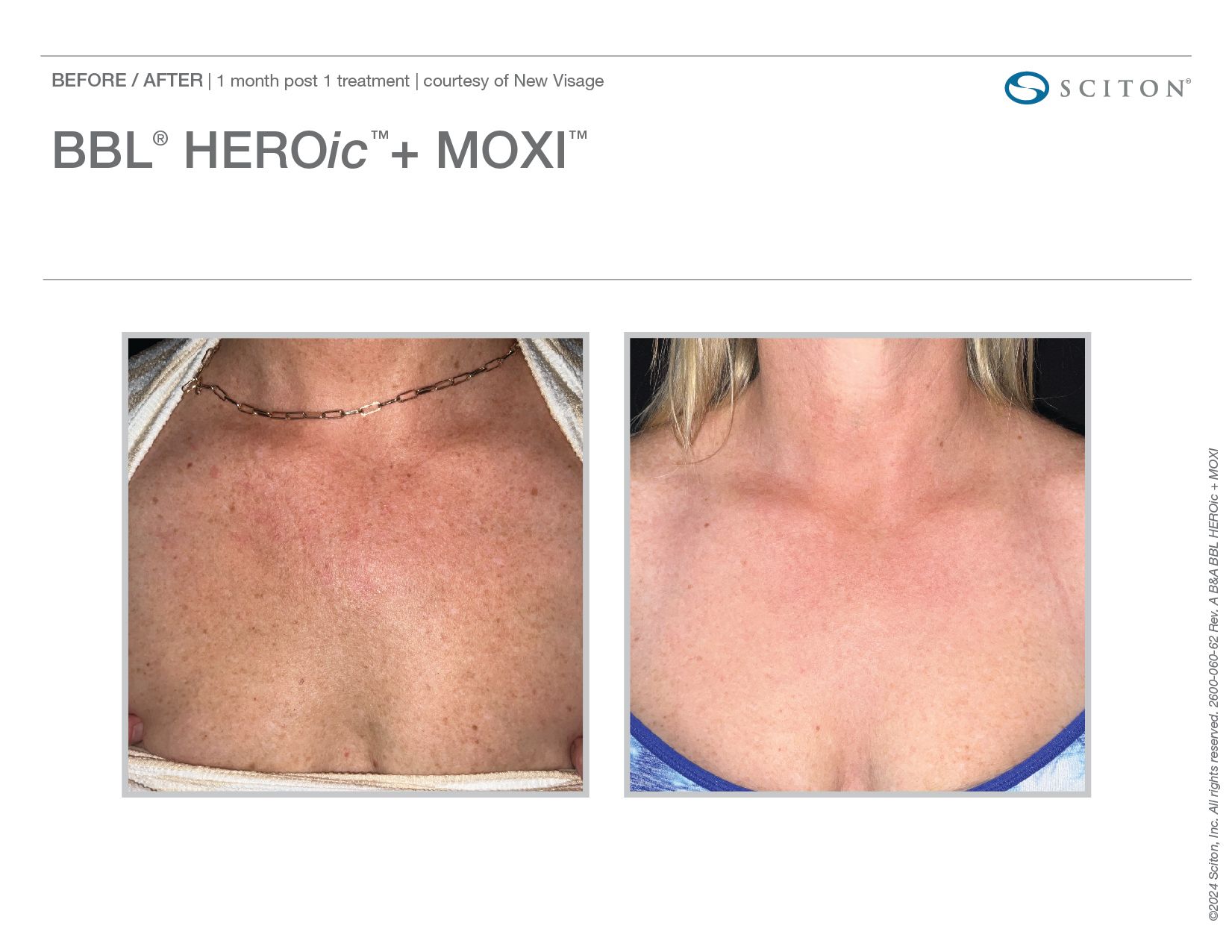
BBL HEROic targets sun damage, redness, and pigmentation, while MOXI, a gentle 1927 nm fractional laser, works on superficial texture and skin renewal.
- Why it works: Addresses the appearance of pigment and texture with minimal disruption.
- Ideal for: Fitz I–IV, patients with early signs of aging or dullness.
- Downtime: Redness for a few hours; social downtime is minimal.
- Provider tip: Recommend a series for deeper benefits without aggressive recovery.
HALO + BBL HEROic: A skin refreshing pairing with visible results, minimal downtime.
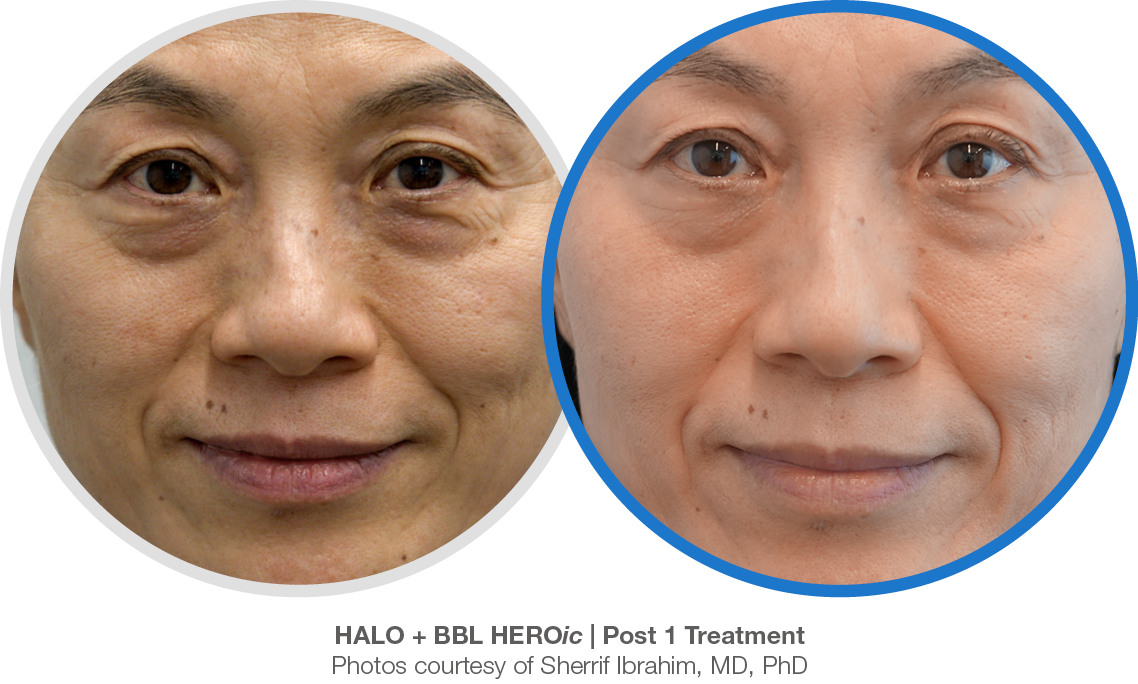
HALO delivers resurfacing, while BBL targets brown spots and uneven tone for a more radiant complexion.
- Why it works: Controlled renewal with minimal disruption—no heavy peeling.
- Best for: Patients already comfortable with HALO or ready to transition into more corrective treatments.
- Downtime: Bronzing or flaking for 5–7 days.
- Provider tip: Position this as a “pre-fall reset” to address summer sun damage before it sets in.
HALO + BBL HEROic + MOXI: A triple threat protocol for glow, clarity, and overall skin vitality.
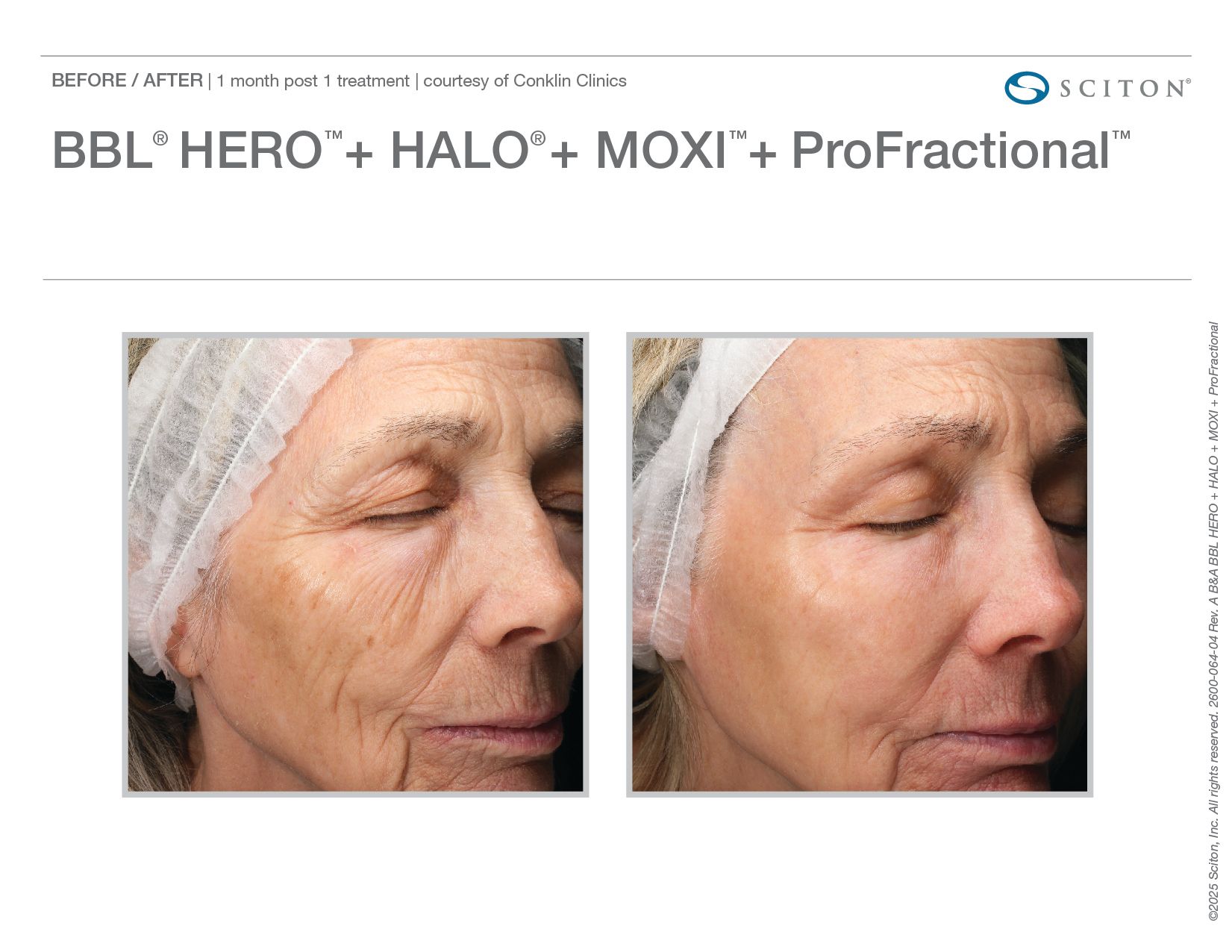
Erin Blackwell, LE, CLT, uses this multi-modality approach to improve the appearance of tone, clarity, and long-term skin health. Learn more from Erin in the ScitonStaX Combination Treatments for Winning Results webinar.
- Why it works: Each device plays a role—HALO resurfaces, BBL reduces redness, and MOXI maintains luminosity.
- Best for: Patients with stubborn hyperpigmentation, acne-prone skin, or those seeking a structured maintenance plan.
- Erin’s Treatment Plan:
-
-
- Start with HALO
- Follow with BBL three weeks later to calm redness or residual inflammation
- Add MOXI every other quarter for glow maintenance
-
- Provider tip: Package as a quarterly “Glow Plan” to keep patients on track year-round.
Browse more before and after images in our gallery.
HALO + MOXI: A multi-tasking treatment for full-spectrum skin renewal in a single session.
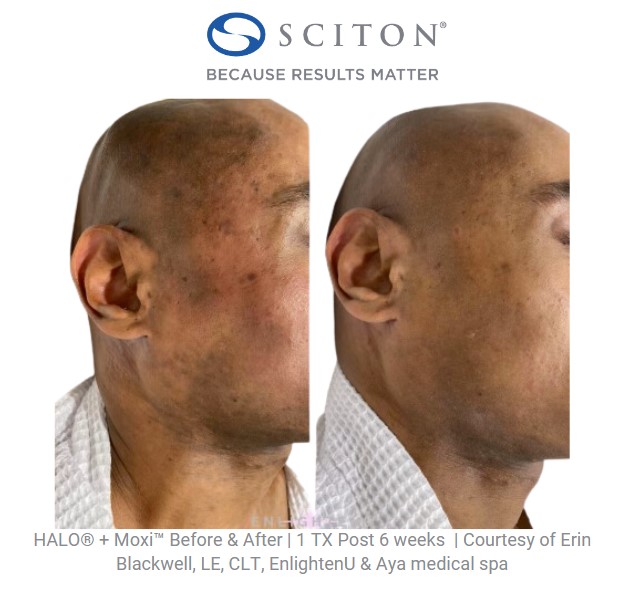
Michelle Ketzler, LE, uses this pairing to help patients achieve faster results, cost savings, and a single recovery period. Hear more from BBLByMichelle on Instagram.
- Why it works: HALO’s dual wavelengths (1470 nm non-ablative + 2940 nm ablative) target sun damage and skin texture, while MOXI enhances luminosity and treats residual pigment.
- Best for: Patients looking for noticeable results with one downtime, or those concerned about pigmentation, tone, and early signs of aging.
- Downtime: 5–7 days of bronzing and mild flaking.
- Provider tip: Highlight this combination as a high-value option that treats multiple layers of skin in one visit—safe for skin types I–VI.
BBL HEROic + ClearSilk: A dynamic duo for redness-prone skin.
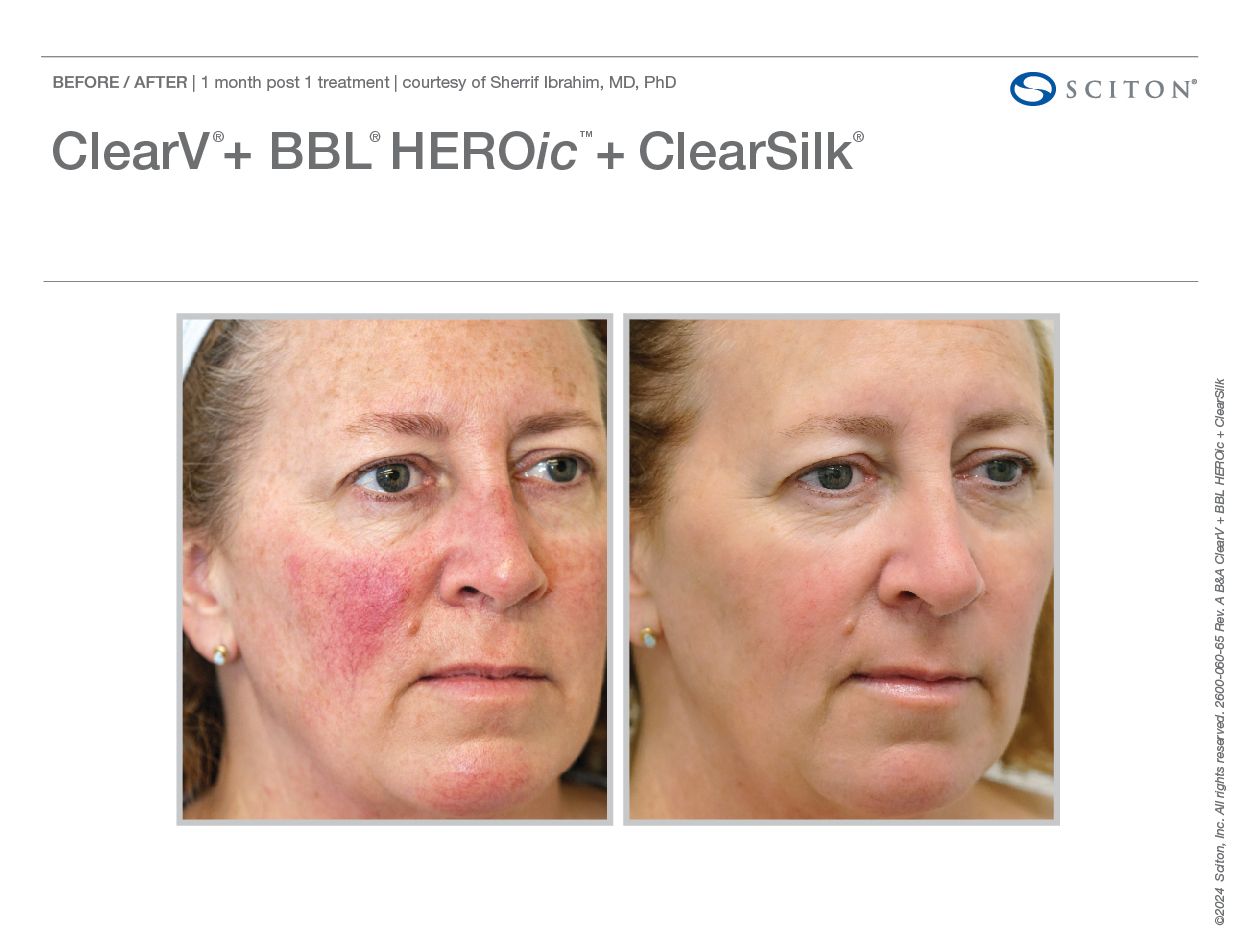
In Dr. Antonio Campo’s white paper, combining BroadBand Light with ClearSilk (Nd:YAG 1064 nm) was shown to significantly improve the appearance of rosacea, flushing, and overall skin tone.
- Why it works: BBL’s 515 and 560 nm filters target superficial vessels, while ClearSilk’s deeper-penetrating 1064 nm wavelength addresses diffuse redness, texture, and dullness.
- Best for: Patients with rosacea, flushing/blushing, or uneven tone looking for non-ablative, low-downtime results.
- Downtime: None—mild redness may occur, but typically resolves within hours.
- Provider tip: Position this pairing as a go-to for patients with sensitive or redness-prone skin seeking a visible yet gentle refresh.
BBL HEROic + ClearV: A vascular StaX solution for deep, complex lesions.
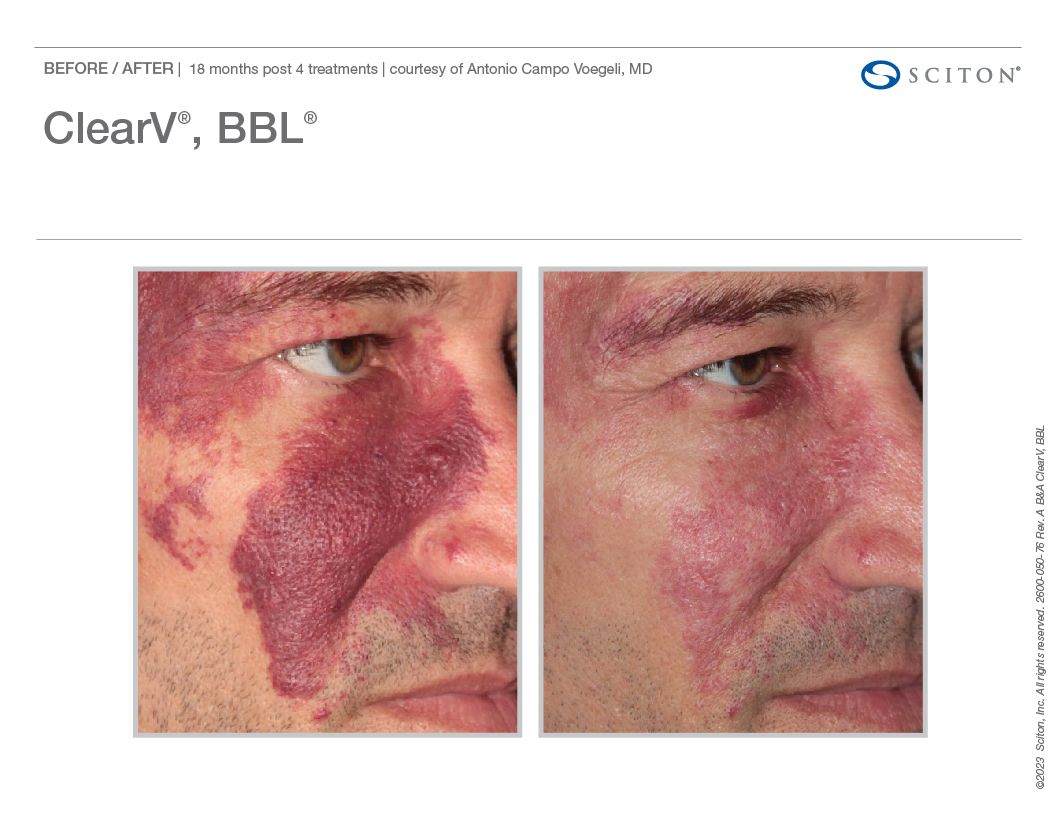
Case studies by Dr. Campo highlight the effectiveness of combining BBL with ClearV (Nd:YAG 1064 nm) to treat port wine stains and hypertrophic vascular lesions.
Why it works: BBL targets superficial vessels, while ClearV’s longer wavelength penetrates deeper to treat high-density, high-complexity vascular structures.
Best for: Patients with port wine stains, hypertrophic or deep vascular lesions, or complex vascular concerns.
Downtime: Mild redness or swelling may occur; typically resolves within a few days.
Provider tip: Use this combo when vascular depth and density demand more than light-based treatment alone—ClearV enhances precision, BBL boosts overall clarity.
Your patients deserve year-round results
The idea that laser treatments should be avoided in summer is outdated, but treating in warmer months still requires precision, planning, and proper patient education. With Sciton’s advanced technologies, the right protocols, and a commitment to compliance, providers can safely address everything from pigmentation and redness to sun damage and more, all year long.
By understanding the risks, adjusting your approach, and using tools like the Summer Laser Checklist, you can deliver real results when your patients need them most without compromising on safety, efficacy, or skin health.


